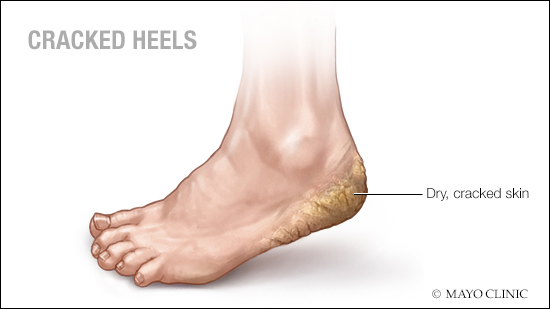-
Mayo Clinic Q and A: Take steps at home to manage dry, cracked heels
 DEAR MAYO CLINIC: The skin on my heels gets very hard and then cracks during the winter. This sometimes gets really painful. What’s the best way to treat cracked heels at home? Is it safe to remove some of the skin?
DEAR MAYO CLINIC: The skin on my heels gets very hard and then cracks during the winter. This sometimes gets really painful. What’s the best way to treat cracked heels at home? Is it safe to remove some of the skin?
ANSWER: Dry skin on the heels that hardens and cracks is common, especially in the winter. There are a variety of self-care steps you can take at home to ease the dryness and heal cracked skin. It’s safe to remove some of the dead skin, as long as you do so gently.
Heels can crack when the skin around the rim of your heel becomes dry and thick, and increased pressure on the fat pad under the heel causes the skin to split. A number of factors can raise the risk of developing cracked heels, including obesity, wearing open-heel footwear such as sandals, and having cold, dry skin. Friction from the back of your shoes can make heel dryness and cracking worse. Wearing supportive, properly fitting, closed shoes with socks may ease symptoms. Losing excess weight also can relieve pressure on your heels and reduce cracking.
Weather often contributes to the problem, too. Skin tends to be driest in the winter when humidity is low and the outdoor temperature is cold. The way homes are heated in the wintertime also has an effect. Fireplaces, wood-burning stoves, central heating and space heaters all reduce indoor humidity, and that dries out skin.
Regularly exposing the skin on your feet to hot water during showers and baths dries skin, too, especially if it’s not moisturized within about 10 minutes after you get out of the bath or shower. Harsh soaps and detergents can damage the natural skin barrier and cause water loss from the skin, worsening the problem.
Skin conditions such as eczema and psoriasis may lead to cracked heels. After menopause, some women may be more prone to a condition known as “acquired keratoderma” — a skin disorder that can lead to cracked skin on the heels and other parts of the body. In those cases, topical estrogen ointments may be recommended to help heal the affected skin.
To combat dry skin, moisturize your feet often. Moisturizers provide a seal over your skin to keep water from escaping and your skin from drying out. Products that contain lanolin, petroleum jelly, glycerin, ceramides, lactic acid, alpha hydroxyl acid or salicylic acid usually help. Moisturize as frequently as you can, especially before you go to bed. Then put on a pair of socks to lock in the moisture overnight.
You also can reduce dry skin by using only gentle soap on your feet; taking warm — not hot — baths and showers; and soaking your feet in plain or soapy water for about 20 minutes, and then gently patting them dry and applying moisturizer right away.
After you soak your feet, a loofah or foot scrubber can help remove dead skin from your heels. But use only gentle pressure, and properly clean and dry the loofah or scrubber between uses.
If self-care measures don’t help, or if your heels become swollen or inflamed, talk to your primary health care provider or a dermatologist. You may need a prescription ointment with stronger moisturizers or a steroid cream to relieve inflammation. Your health care provider may recommend special bandages or a tissue glue to protect the skin and hold the edges of the cracks together, so they can heal.
In some cases, dry, cracked skin could be a sign of a more significant health issue, such as diabetes or loss of nerve function. If you suspect an underlying medical condition, talk to your health care provider to see if you need further evaluation. — Dr. Gabriel Sciallis, Dermatology, Mayo Clinic, Rochester, Minnesota
****************************
Related Articles
- Mayo Clinic Minute: Winter skin protection tips published 1/22/18
- Home Remedies: Dry skin difficulties published 1/10/18







